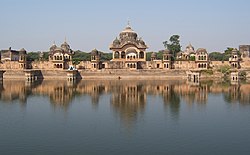Vrindavan
| Vrindavan वृन्दावन |
||
|---|---|---|
|
|
||
| State : |
|
|
| State : | Uttar Pradesh | |
| District : | Mathura | |
| Location : | 27 ° 35 ' N , 77 ° 42' E | |
| Height : | 186 m | |
| Area : | 13.5 km² | |
| Residents : | 63,005 (2011) | |
| Population density : | 4667 inhabitants / km² | |
| Vrindavan - Kusuma Sarovar Ghat | ||
Vrindavan ( Hindi वृन्दावन ) is a town with a population of around 70,000 in the Mathura district of the Indian state of Uttar Pradesh . For the followers of the Hindu god Krishna it is a holy city.
Location and climate
Vrindavan is about 186 m above sea level on the west bank of the Yamuna about 8 km north of the city of Mathura . The city of Agra is about 75 km to the southeast and India's capital Delhi is about 145 km to the north. The climate is warm to hot; Rain (approx. 720 mm / year) almost only falls in the summer monsoon months .
population
| year | 1991 | 2001 | 2011 |
| Residents | 47,746 | 56,692 | 63.005 |
Approx. 92.5% of the population are Hindus , 7% are Muslims ; the rest is distributed among other religions ( Sikhs , Jains , Buddhists , Christians ). The proportion of the male population is around 20% higher than the female population, which - in addition to the abortion of female fetuses, which is more common in India - is also due to the immigration of male workers.
Widows
Many penniless Hindu widows who have been rejected by their families come to Vrindavan to spend the rest of their lives there. They hope to find salvation in Vrindavan from the misfortunes widely believed widows should bring by dedicating their lives to Krishna. Most of them live as beggars and have no social security whatsoever.
economy
Most of the residents of Vrindavan live, directly or indirectly, from farming in the surrounding villages. Craftsmen, small traders and service providers have settled in the city itself. Pilgrimage tourism plays an extremely important role in the city's economic life .
mythology

According to tradition, the city of Vrindavan is the location of the former forest of Vrindavana , in the vicinity of which the Hindu god Krishna is said to have grown up in Gokul , a village of cow herders . According to the Bhagavatapurana and the Gita Govinda , Krishna tended cows in the forest of Vrindavan; there he also met the shepherd girls, the Gopis , and it is here in particular his relationship with Radha that is told in many stories that are extremely popular all over India. The game of Radha and Krishna has a deep symbolic meaning in Hinduism as the divine game ( purple ) of the soul with its Lord.
history
Despite the probably long history of the square, today's city was only founded in the 16th century and equipped with numerous temples; she grew up quickly.
Attractions
Today little reminds of the historic forest. Instead, there are dozens in Vrindavan historical and modern Hindu temples (mandira) that Krishna consecrated; however, none of them are older than 500 years. Almost every house has an altar dedicated to the worship of Radha and Krishna; therefore Vrindavan is often called the “city of 5000 temples”. The place is one of the most popular pilgrimage sites for Vishnuits from all over the world.
- The Shikhara tower of the Madan Mohan Temple , which rests on a high substructure, is covered with ornamental square terracotta plates. It is considered to be the oldest temple in Vrindavan. The original cult image was brought to Karauli (Rajasthan) during the time of the Great Mogul Aurangzeb to protect it . A copy is venerated in Vrindavan.
- The Govinda Dev Temple , financed by Raja Man Singh I of Amber and clad with red sandstone slabs , was reduced from 7 to 4 floors during the time of Aurangzeb and stripped of all its figural decorations.
- The Ranganath Temple was built between 1845 and 1851; its gate construction ( gopuram ) refers to the two donors from the southern Indian city of Madras .
- The Banke Bihari Temple , Krishna's main shrine in Vrindavan, was also not built until the middle of the 19th century.
- The construction of the so-called Jaipur Temple was initiated by the Maharaja of Jaipur Sawai Madho Singh II at the end of the 19th century and completed in 1917.
- The Krishna Balaram Mandir was donated by the International Society for Krishna Consciousness (ISKCON) in the 1970s and built in a mixed Indo-European style. On the grounds is also the marble - Mausoleum of Bhaktivedanta Swami Prabhupada , founder of the company.
- The Prem Mandir , completely clad in white marble and built in the style of medieval Hindu temples, is considered the most beautiful and largest temple in Vrindavan. The foundation stone was laid in 2001.
Votive tablets in a temple
Web links
- Vrindavan, temple - Photos and information (English)
- Vrindavan, temple - Photos and Info + Links to other temples in Vrindavan (English)








